
eID for business in Belgium
| eID for business in Belgium The citizen will receive his identity card from his municipality, which is electronically connected to the federal government, the approved societies and the certification authorities that participate to the eID project at various levels. The National register also plays a key part in the organization as well as in the surveillance of the system. |
 |
Objective of the eID The implementation of the electronic identity card (eID) is part of an e-Government project in order to simplify the administration and to modernize the public services. |
Objective of the eID
The implementation of the electronic identity card (eID) is part of an e-Government project in order to simplify the administration and to modernize the public services.
The electronic identity card allows the citizen to identify himself electronically from a distance and to dispose of a legally valuable electronic signature. The result is a quick and customer-oriented service which guarantees the security of the private data of the owner.
The appearance of those applications combined with the legal recognition of the electronic signature will rapidly and safely replace a part of the paper documents by their electronic equivalent.
Visible data
The electronic identity card has the same size as a bank card. The basic identity informations are visible (name, first name, gender, nationality, place and date of birth, signature, national number and period of validity of the card) and you will also find a photo of the bearer. These informations (picture included) are also electronically contained in the card. The address of the owner and two electronic certificates complete the information’s that are encrypted on the chip.
| Objective of the eID The implementation of the electronic identity card (eID) is part of an e-Government project in order to simplify the administration and to modernize the public services. The electronic identity card allows the citizen to identify himself electronically from a distance and to dispose of a legally valuable electronic signature. The result is a quick and customer-oriented service which guarantees the security of the private data of the owner. The appearance of those applications combined with the legal recognition of the electronic signature will rapidly and safely replace a part of the paper documents by their electronic equivalent. Visible data The electronic identity card has the same size as a bank card. The basic identity informations are visible (name, first name, gender, nationality, place and date of birth, signature, national number and period of validity of the card) and you will also find a photo of the bearer. These informations (picture included) are also electronically contained in the card. The address of the owner and two electronic certificates complete the information’s that are encrypted on the chip. Electronic data The chip of the electronic identity card contains the following information: |
| the same informations as the one that are visible on the card (including the picture)the address of the card owner;the identity and signature keys;the identity and signature certificates;the service provider of the certification;the information necessary for the authentification of the card;the information necessary for the for the protection of the electronically visible data that are encrypted on the card;the information necessary for the use of the corresponding qualified certificates. |
| The standard digital certificates allow the citizens to make an electronic signature and to identify themselves when they perform electronic transactions. They are also valid for the different e-Gov applications and for a private use, like for example: |
| sending of electronic registered mail;signed e-mails;online signing of contracts;authentification by web browsers (e-Banking, e-Contracting…) |
| Possibilities Baring in mind that this list is not exhaustive, here some ideas of how to use the card: |
| At the counter At numerous counters, you have to verify the identity of the person first before you can manually introduce those data in a computer. Thanks to the eID, all this will be done automatically and without any error.On-line contracts and “tele-statements”… At any time of the day and without leaving your home, you can complete and sign on-line forms, contracts, and documents. The automatic treatment of these forms simplifies the manual process and allows the drawing of new information and opportunities thanks to an electronically operated information.Physical access control The authentification based on the eID offers a greater security access without generating supplementary compatibility problems and allows the use of a limited infrastructure investment.On-line access control It is possible to control the access to website portals, websites for the exchange of files, Webmail, limited users collectivity, teleworking, fidelity programs, e-Commerce, tickets sale, and so on. In the SSL protocol, the eID card can be immediately used without any supplementary development. |
| Examples Here are some more concrete examples of the eID card |
| Car and tool renting… The service on the counter is improving thanks to the acceleration of the administrative tasks.Banks / Insurance companies Statements without having to move, information demands by using the eID, signing of standard contracts and opening of an account without having to go out, access control to make operations on accounts, simplification of the security measures used in telebanking…Ticketing services On-line reservations are easier thanks to the identification of the inquirer.Direct contact with the customers By putting new services on-line, you will benefit a direct contact with your clients, who are perfectly identified.Telework Your employees can do telework without needing important technological security investments. |
Knowledge based Risk Management

Summit for the Future 2006 on Risk May 3-5
from the program ….
Interdisciplinary Stream:
Values and Spirituality
Why do human beings resort so quickly to armed conflict when it is so clear that no one really wins wars? Why do we refuse to adapt dialogue and reconciliation as means to resolving conflict in spite of evidence that it works and wars don’t? Why is there such widespread public legitimacy for outmoded ways of thinking about leadership and the future? Are human beings ready to leap into a new consciousness, a more mature stage in our evolution, and become “global patriots”? There is no doubt that we have the ability to make this leap. The question: will we choose to?

John Renesch, Author, Getting to the Better Future: A Matter of Conscious Choosing
Conscious Living, Conscious Work: Becoming Global Patriots
San Francisco-based author John Renesch points to the opportunity facing humankind to consciously evolve to a new and unprecedented level of maturity, and create a just, sustainable and compassionate world. By adopting a new worldview, human beings can take advantage of the extraordinary possibilities that are inherent in what he refers to as “a communion of technology with spirit,” or co-creation. This option has never before been available in human history and, if recognized and acted upon, can launch us into a new era of maturity, wisdom and consciousness.

Bill Liao, Senior Partner & Director, openBC / CEO Finaxis AG
Reputation Risk – how to survive networking in the digital age
Reputation is closely linked to your system of values …
Manging risk to your reputation involves
– identifying your values …
– communicating them clearly and
– making sure to reflect them in your actions …
Moderated by Jonathan Marks, Director, Critical Distance BV
Club of Amsterdam blog
 | Club of Amsterdam blog October 26: Synthesis of elBulli cuisine October 14: The new Corinthians: How the Web is socialising journalism September 20: A Future Love Story |
News about the future of Electronic Identity

Sxip Identity
Sxip Identity is building simple, secure, and open Identity 2.0 solutions for the Web.
Sxip Access: On-Demand Identity Management
As critical customer data moves beyond your firewall, control over access and usage should not. The unique provisioning and single sign-on capabilities of Sxip Access extend the security and manageability of your corporate network to your hosted application.
SXIP: Enabling Authentic Internet Identities
SXIP – the Simple, eXtensible Identity Protocol is the power behind Identity 2.0. SXIP is a simple mechanism that gives users control over their online identities and provides websites with the ability to construct rich user-centric relationships.

“Smart University” (2nd edition) is an educational programme dedicated to advanced technologies of Smart Card, e-ID and AmI. Successfully launched in 2005 “Smart University” relies on a strong academic background provided by its 15 partner European Universities. This approach is completed by cases and live testimonials from R&D labs and industry researchers that focus on the newest developments of technologies…
News about the Future

Sugars to make polylactic acid
NatureWorks produces and sells a renewable-resource-based resin derived entirely from the sugar found in common field maize (corn).
Examples:
QDC’s PET bottles can be custom molded to provide the size or shape. With its clarity and its ability to project no odor and no taste, QDC’s PET bottle is the perfect compliment to water, juice, and even milk
Called “CornCard USA” by Arthur Blank & Co., the card itself can be composted, incinerated and mechanically recycled in industrial facilities. This new corn-based card can be used in the same applications as the more traditional petroleum-based counterparts.

Financial Times series on “mastering risk”
A delicate balance between risk and reward
By Eamonn Kelly and Steve Weber
Is risk bad for business? In the uncertain, complex and volatile environment of 2005, it no doubt seems to many executives to be so. Risk is something to be managed, reduced, hedged or sold to others. But it is worth recalling that the original concept of risk, derived from early European seafaring adventurism, contained a powerful sense of opportunity and reward as well as downside and danger.
We believe that, in the future, winning businesses will be those that are best able to balance coping strategies, which are defensive and focused on avoiding downside risks, with an increasing mix of exploitation and exploration strategies, which embrace risk and make the most of the opportunities it presents. This will require more than just continuous improvement in traditional risk management tools – it will also involve a shift in mindset and focus.
Next Event: Wednesday, March 29, 16:30-19:15
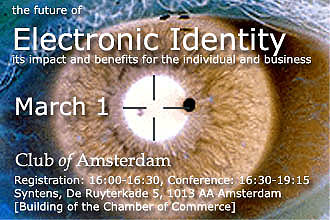
the future of Electronic Identity
Wednesday, March 1st, 2006
Registration: 16:00-16:30, Conference: 16:30-19:15
Where: Syntens, De Ruyterkade 5, 1013 AA Amsterdam [Building of the Chamber of Commerce]
WithJan Willem Broekema, Programme Manager, Open Source Software programme OSOSS, National Co-ordinator Open Standards:ID by Law – Is the European Directive valid in 10 years?
Dennis van Ham, Consultant, Information Risk Management, KPMG:
Electronic identity: are you (proven) in control?
Marcel van Beek, Program Manager, Passenger Process, Amsterdam Airport Schiphol:
The new self service airport and the role of electronic identity
and our Moderator Homme Heida, Promedia, Member of the Club of Amsterdam Round Table
Summit for the Future blog
 | Summit for the Future blog http://summitforthefuture.blogspot.com July 13: Summary of the Summit for the Future 2006 May 22: Dispatches from the Frontier |
Recommended Book
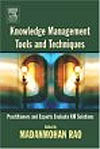
Knowledge Management Tools and Techniques : Practitioners and Experts Evaluate KM Solutions
by Madanmohan Rao
Knowledge management (KM) – or the practice of using information and collaboration technologies and processes to capture organizational learning and thereby improve business performance – is becoming one of the key disciplines in management, especially in large companies. Many books, magazines, conferences, vendors, consultancies, Web sites, online communities and email lists have been formed around this concept.
This practical book focuses on the vast offerings of KM solutionstechnology, content, and services. The focus is not on technology details, but on how KM and IT practitioners actually use KM tools and techniques. Over twenty case studies describe the real story of choosing and implementing various KM tools and techniques, and experts analyse the trends in the evolution of these technologies and tools, along with opportunities and challenges facing companies harnessing them. Lessons from successes and failures are drawn, along with roadmaps for companies beginning or expanding their KM practice.
The introductory chapter presents a taxonomy of KM tools, identifies IT implications of KM practices, highlights lessons learned, and provides tips and recommendations for companies using these tools. Relevant literature on KM practices and key findings of market research groups and industry consortia such as IDC, Gartner and APQC, are presented.
The majority of the book is devoted to case studies, featuring clients and vendors along the entire spectrum of solutions: hardware (e.g. handheld/wearable devices), software (e.g. analytics, collaboration, document management) and content (e.g. newsfeeds, market research).
Each chapter is structured along the “8Cs” framework developed by the author: connectivity, content, community, commerce, community, capacity, culture, cooperation and capital. In other words, each chapter addresses how appropriate KM tools and technologies help a company on specific fronts such as fostering adequate employee access to knowledge bodies, user-friendly work-oriented content, communities of practice, a culture of knowledge, learning capacity, a spirit of cooperation, commercial and other incentives, and carefully measured capital investments and returns. Vendor history, product/service offerings, implementation details, client testimonials, ROI reports, and future trends are highlighted.
Hydropolis
Hydropolis
Hydropolis in Dubai is the world’s first luxury underwater hotel.

In order to enter this surreal space, visitors will begin at the land station. This 120m woven, semicircular cylinder will arch over a multi-storey building.

We want to create the first ever faculty for marine architecture because I believe that the future lies in the sea, including the future of city planning. I am certain that one day a whole city will be built in the sea. Our aim is to lay the first mosaic by colonising the sea.”
Architect Hauser plans to incorporate many different elements associated with the sea. He views his creation as a place where those who do not dive – or do not even swim – can experience the tranquillity and inspiration of the underwater world.

Announcements

Don’t Stop
Business Innovation Conference in Copenhagen on 15 March 2006.
Copenhagen Institute for Futures Studies (CIFS) presents some of the worlds most innovative thinkers. They are the creators of the ideas that will shape the future of our society and your business. And they all have successful experience implementing them – in Shell, IKEA, Coca-Cola, IBM, PlayStation, Apple, UK Cabinet Office, etc. If you’re looking for the winning ideas of tomorrow, be part of this unique international event and experience how these masters of the Creative Class think. Be inspired by their knowledge and ideas and feel the transformation power. Meet Arie de Geus, Adam Morgan, John Grant, Geoff Mulgan, and CIFS on this event.

Brian Tracy about Maximum Achievement
One of the most popular professional speakers from the US is coming to The Netherlands on April 27th. Brian Tracy is the world’s leading authority on personal and business success. He had written more books, formulated more specific training programs and impacted more people in the corporate and entrepreneurial world than probably any other respected author, lecturer or peak performance expert. In Amersfoort he will speak about achieving more results, strategies and habits of high performers and Leadership.
Agenda
| March 1 the future of Electronic Identity April 26 the future of Drugs & Pharma Wednesday, April 26, 2006, 16:00-19:15 Location: Info.nl, Sint Antoniesbreestraat 16, 1011 HB Amsterdam [Next to Nieuwmarkt] May 3 Opening Event Summit for the Future 2006 May 3, morning When: Wednesday, May 3, 2006 May 3-5 Summit for the Future 2006 May 3-5, 2006 The topics are Life Sciences, Media & Entertainment, Trade – Asia, Healthcare, Corporate Governance, Innovation as Risk Taking, Knowledge based Risk Management, Values and Spirituality, Cross-Cultural Competence and Creative Leadership. Where: HES School of Economics and Business, Fraijlemaborg 133, 1102 CV Amsterdam Zuidoost |
| May 31 the future of Reputation Management |
| June 28 the future of Journalism / Ethics in Journalism |
Club of Amsterdam Open Business Club
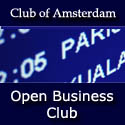 | Club of Amsterdam Open Business Club Are you interested in networking, sharing visions, ideas about your future, the future of your industry, society, discussing issues, which are relevant for yourself as well as for the ‘global’ community? The future starts now – join our online platform … |

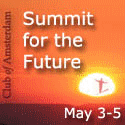
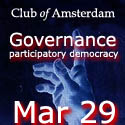
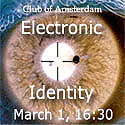

Customer Reviews
Thanks for submitting your comment!